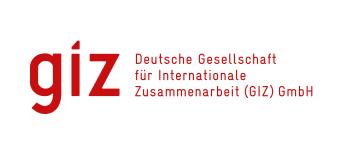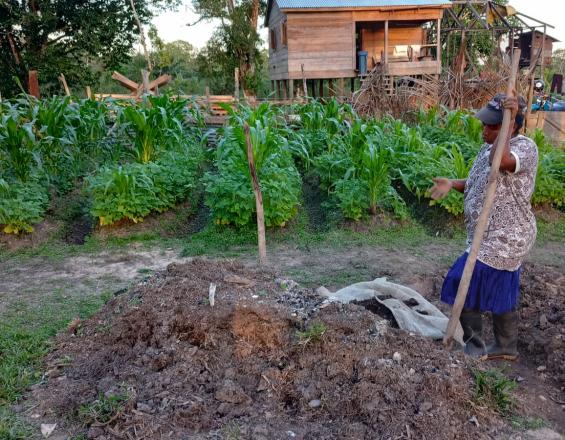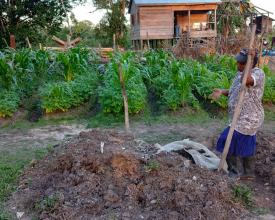
Sustainable Natural Resource Management under Climate Aspects in Indigenous Territories in La Mosquitia’

The project ‘Sustainable Natural Resource Management under Climate Aspects in Indigenous Territories in La Mosquitia’, runs until 2023, aiming to achieve sustainable and climate-adapted use of the province’s natural resources. It focuses on strengthening governance structures to encourage the local population to participate in planning.
The case of Honduras / La Mosquitia illustrates the importance of integrating justice issues into the project during the early stages of planning. Integrating these issues into governance structures and processes in the project area is essential, although project management must also consider them. The strategic entry points for anchoring justice issues include the project concept, steering structure, monitoring and evaluation (M&E) system, and staff concept. Integrating the various dimensions of justice – recognition, procedural and distributive through these entry points is a key prerequisite for justice to be considered in project implementation.
Context
Challenges addressed
Mosquitia encompasses the 12 Indigenous territories of the Miskitu, with about 100,000 inhabitants. More than half of rural families live in extreme poverty, and 85% of households suffer from food shortages. Women and children suffer particularly from the effects of poverty.
The forests of Mosquitia are endangered by illegal deforestation resulting from the unregulated influx of non-Indigenous cattle producers and a lack of state strategies and support mechanisms for the sustainable use of natural resources. Additionally, the indigenous territorial councils in Honduras can barely exercise stewardship over their own land.
Moreover, climate change threatens the livelihoods of the local population as droughts, floods, forest fires, and storms become more frequent, putting pressure on agriculture and leading to crop losses. Recurring damage and rapidly changing climate conditions exceed the adaptation capacities of the local population.
Location
Process
Summary of the process
The building blocks highlight the importance of a justice-based approach for successful project implementation. In addition, the involvement of the local population from the beginning, both in planning and implementing ecosystem-based adaptation (EbA) through agroecological approaches, was vital in providing the stakeholders with a strong sense of project ownership and political recognition of its participatory approach. The philosophy of project staff to serve more as process moderator between key stakeholders than as technical implementer of actions served to participate a wide variety of actors which focused their individual interests on the solution of common problems, in this case EbA. This led to positive side effects, as can be seen by the community “multipliers” who give their communities a kind of technical assistance already without project intervention.
Building Blocks
1. Establishment of an operational committee with representatives of the Indigenous population, local authorities and other important stakeholders for joint project management
In the project areas, the project launched an operational committee responsible for selecting local support measures (e.g., infrastructure and capacity development), based on mutually agreed criteria, such as women’s participation, interest in the measure and its chances of being sustainable.
This body included two representatives (at least one a woman) from each of the five territorial councils as well as representatives from the municipalities (two), departments of forestry and agriculture (two), local NGOs (two), a university (one), the World Food Programme (one) and the implementing organisation, GIZ (four). Meeting regularly every three months, the committee handles joint project management, including annual planning, project monitoring, and dealing with risks and conflicts.
Enabling factors
A major demand was expressed for stronger participation mechanisms and increased efforts to improve local livelihoods, which meant that there was already support for the establishment of an operational committee.
GIZ has been active in the region for more than 15 years and thus has very good relations at the local level, which facilitate access to important information and information carriers. The cooperation by a consortium of an international Consulting and international NGO present in the area was another positive factor.
Lesson learned
- Governance should be a core element of every EbA project, if it is to follow best practices for justice-based EbA (i.e., strengthening the rights of Indigenous Peoples, particularly women, in decision-making and in preventing or moderating conflicts). Very important in this respect is the awareness building in national institutions to adapt their norms and procedures to the needs of indigenous communities.
- Early involvement of the local population in project conception together with the use of local experts and knowledge are crucial for gaining acceptance of the EbA approach. Moreover, in the appraisal process of new projects, it is essential for the local population to be properly informed and heard, so that it can adequately advocate and prioritize demands and needs.
2. Installation of problem-solving platforms, which serve as working groups for conflict resolution and consensus building, especially on land tenure and resource use issues
The project initiated various platforms for problem solving (e.g., one on delineation of borders between territorial units); the platforms serve as working groups for conflict resolution and consensus building. When creating the platforms, the project appointed members from the different stakeholder groups, provided them with intensive training and guidance, and established complaint mechanisms.
Enabling factors
GIZ considered the reality of marginalized groups within the Indigenous population and their development vision. To this end, it closely involved the local population in project conception, relying on Free Prior Informed Consent (FPIC) as a decisive principle for action. In addition, promoting dialogue between local communities, Territorial Councils, and Municipalities is necessary to minimize conflict and build trust between different actors.
Lesson learned
- Safeguard systems and conflict analyses can help identify risks and integrate appropriate measures into the project concept and implementation.
- In the project planning phase, it is crucial to allow enough time and budget for participatory development of the project approach and for meaningful safeguards processes.
3. Identification of flexible project implementation mechanisms, which can reflect demands at the local level (e.g., contracting of local employees from the Miskitu population)
For this purpose, the project contracted two international consulting agencies with a long-standing on-site presence. In the tender documents and selection process, GIZ focused on prerequisites such as expertise in conflict prevention and human rights-based approaches as well as gender justice in particular. Based on the terms of reference formulated by the project, the consortium contracted local employees, who serve as trusted brokers, possess the necessary language skills and cultural empathy as well as the required expertise and understanding of the project logic from the donor perspective. In addition, the project contracted national consultants to strengthen the capacities of the local population and their institutions.
Enabling factors
GIZ held meetings at the village, territorial, and project area levels with appraisers of the new project. The results were synchronized with local development plans (planes de vida). Crucial factors had been the initial informed consultation and participation of the local population in designing micro-projects and employment opportunities for indigenous personnel. Another factor is the project's principle not to work with the population, building capacities on a local level in various aptitudes.
Lesson learned
- Project acceptance and success depend critically on an approach that is strongly oriented to implementation at the local level and is holistic in nature, in the sense that it is oriented to local needs.
- Flexible project design is key to take into account suggestions of different stakeholders decisive for project implementation.
- Capacity building in formal (i.e., diplomas) and informal (local “multipliers”, horizontal learning through structured experience exchange, etc.) ways is key to sustainability of actions.
Impacts
By applying the FPIC approach in its work and relying on permanent on-site support from technical consultants on the Miskitu culture, the project has managed to anchor the planned development efforts in local communities and to build a sense of project ownership amongst them. By applying methods for participation and non-violent conflict resolution, particularly with respect to land-tenure issues, the project has helped settle border disputes between neighbouring territorial units and pacify different currents within the umbrella organisation MASTA of the Miskitu. This facilitated in getting central state actors and Indigenous administrations to work together to solve problems and conflicts (e.g., concerning sustainable forest management plans). As a result, these groups now have a better mutual understanding of one another’s situations, and conflict-resolution mechanisms have improved. Representatives of Indigenous communities highly appreciate the participatory and inclusive character of project planning and implementation, which the project’s directive committee also recognises as exemplary at the national level. As a consequence, the project now serves as a blueprint for the interventions of organisations such as the Department of Indigenous and Afro-Honduran Peoples of Honduras.
Beneficiaries
25 indigenous communities located in 5 out of 12 Indigenous Territories, a population of about 12.500 inhabitants are currently benefitting directly from the project.
Sustainable Development Goals
Story
In the community of Dakratara, Mosquitia, Honduras lives Luz Bosen, a woman committed to growing plants and vegetables to meet her family's food needs and to set an example for here community. Before Pana Pana project was present in Dakratara, people used to plant basic crops (rice, beans, cassava, banana) on the riverplains, distant from the community. The knowledge of the population about crops was little, reason that made it easy for plant diseases and pest. The result was long ways and low crop yield, among others.
Pana Pana in action
The Pana Pana project of the German Development Cooperation (GIZ) has developed in La Mosquitia a practice that consists of a training process through the methodology of Field Schools, aimed at improving production systems with the incorporation of diversified foods and good agricultural practices from the rescue of knowledge and traditional techniques. Pana Pana established the cultivation of several crops in an ordered form and distance on the same field, raising furrows or piles to defend the seeds against inundation or drought. As fields and gardens are brought near to homes, it was necessary to teach the elaboration of organic fertilizers and pesticides in order to improve the soil. Diversification of plant species helps in this respect, but also to improve nutrition.
Luz, as community leader, now teaches here neighbors, how to diversify their diet, carry out their work close to home and harvest their own food. Luz has become a woman of reference in this community for her leadership and her diversified family garden, just as she is a reverence for an example of what women can achieve.


